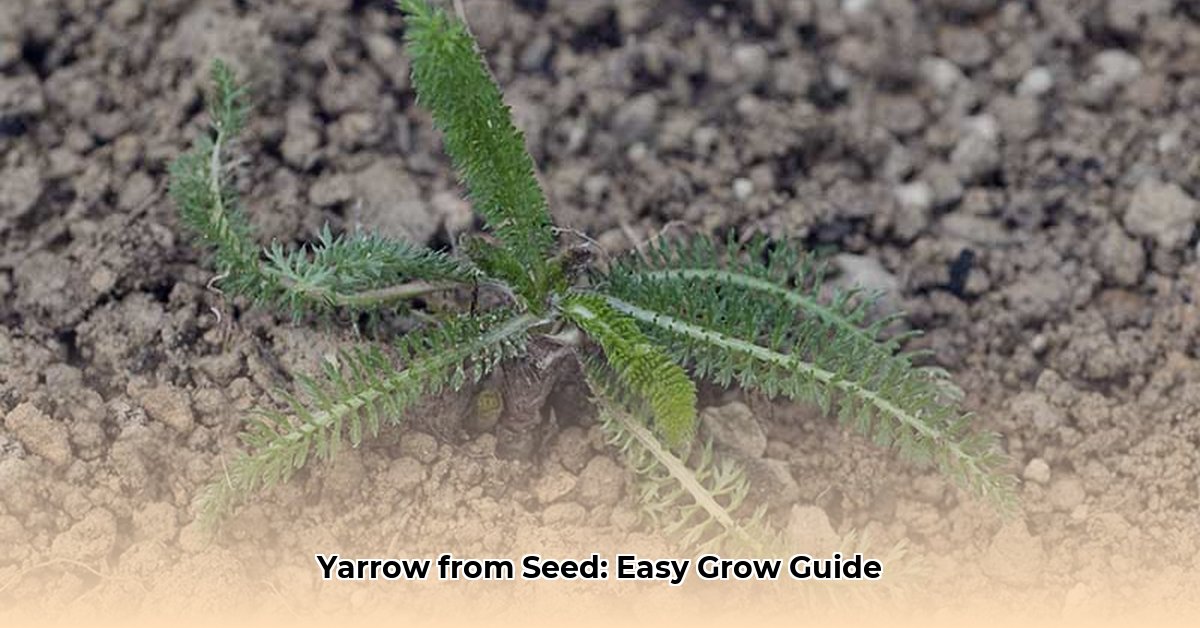Yarrow, with its feathery foliage and cheerful blooms, adds a touch of wildflower charm to any garden. This comprehensive guide focuses on growing yarrow (Achillea millefolium) from seed, providing clear instructions and helpful tips for success, from sowing to troubleshooting.
Starting Your Yarrow Seedlings: Two Approaches
You have two main options for starting yarrow seeds: indoors or directly outdoors. Each method has its advantages, so consider your climate and gardening style.
Indoor Sowing (6-8 weeks before last frost)
Starting seeds indoors gives you a head start, especially in colder climates.
- Prepare Containers: Use seed trays or small pots filled with a well-draining seed-starting mix. This provides the ideal texture for delicate roots.
- Sow Seeds: Lightly scatter seeds over the mix and gently press them down. Yarrow seeds need light to germinate, so don’t bury them.
- Moisture & Warmth: Keep the mix consistently moist but not waterlogged. Aim for a temperature between 65-72°F (18-22°C). A heat mat can be helpful.
- Light: Place your seed trays in a bright location, but out of direct sunlight until germination. Once seedlings emerge, provide plenty of light, using grow lights if necessary.
- Hardening Off: Before transplanting outdoors, gradually acclimate seedlings to outside conditions over 7-10 days.
Direct Outdoor Sowing (after last frost)
This method is simpler, mimicking yarrow’s natural growth.
- Prepare Soil: Loosen the soil and remove weeds. Amending with compost improves drainage and nutrients.
- Sow Seeds: Scatter seeds thinly over the prepared soil and lightly rake them in, about 1/8 inch deep.
- Moisture: Keep the soil consistently moist until seedlings emerge. A light spray from a watering can works well.
Yarrow Seedling Care: Nurturing Growth
Once your yarrow seedlings emerge, whether indoors or outdoors, follow these guidelines:
Light:
Yarrow thrives in full sun (6-8 hours daily). While some shade is tolerated, ample sunlight promotes vigorous growth and abundant blooms.
Water:
Water regularly until established, then reduce frequency. Yarrow becomes quite drought-tolerant once its roots are established, reflecting its adaptability to drier conditions in its native habitats.
Soil:
Well-draining soil is essential. While adaptable to various soil types, from sandy to clay, yarrow struggles in waterlogged conditions. Amend heavy clay soils with organic matter (compost or well-rotted manure) to improve drainage.
Spacing and Thinning:
Thin seedlings to 12-18 inches apart, or even up to 24 inches for certain varieties, to prevent overcrowding and promote air circulation, reducing the risk of fungal diseases.
Fertilizing:
Yarrow isn’t a heavy feeder. A light application of balanced fertilizer in early spring is generally sufficient. Over-fertilizing can lead to leggy growth and reduced flowering.
Troubleshooting: Addressing Potential Problems
Damping Off:
This fungal disease can cause seedlings to wilt and collapse. Ensure good air circulation and avoid overwatering. Research suggests that using sterilized seed-starting mix can also help minimize the risk.
Pests:
Aphids are sometimes attracted to yarrow. A strong spray of water can dislodge them. Insecticidal soap or neem oil can be used for more persistent infestations. Introducing beneficial insects like ladybugs can also provide natural pest control.
Tips for Success
- Quality Seeds: Use fresh, high-quality seeds for optimal germination rates.
- Scarification & Stratification (Optional): Some studies suggest that scarification (gently scratching the seed coat) and cold stratification (exposing seeds to cold, moist conditions for a few weeks) may improve germination, particularly for some yarrow varieties.
- Bottom Watering: This technique helps prevent damping off by keeping foliage dry.
FAQs about Yarrow Seedlings
- How long do yarrow seeds take to germinate? Germination typically takes 10-30 days, varying with conditions and variety. Factors such as temperature and moisture levels can also influence germination time.
- What’s the ideal temperature for germination? Aim for 60-72°F (15-22°C).
- Can I grow yarrow from cuttings? Yes, yarrow can be propagated from cuttings in spring or fall. This allows for faster establishment than growing from seed.
- When does yarrow bloom? Yarrow typically blooms from late spring to early fall. Deadheading spent flowers can encourage further blooming.
The Versatile Yarrow: More Than Just a Pretty Flower
Yarrow offers many benefits beyond its beauty. It attracts pollinators, is drought-tolerant once established, and has a history of medicinal use. Some studies suggest potential benefits for wound healing and inflammation, but more research is needed.
By following these guidelines and enjoying the process, you’ll soon have healthy, flourishing yarrow plants adding beauty and resilience to your garden.
- Greenhouse Storage Shed Combos: Your Guide to Combining Growing and Storage - April 21, 2025
- Greenhouse Shed Combo: Design, Build & Grow Year-Round - April 21, 2025
- Gingham vs. Plaid: What’s the Difference? A Complete Guide - April 21, 2025










